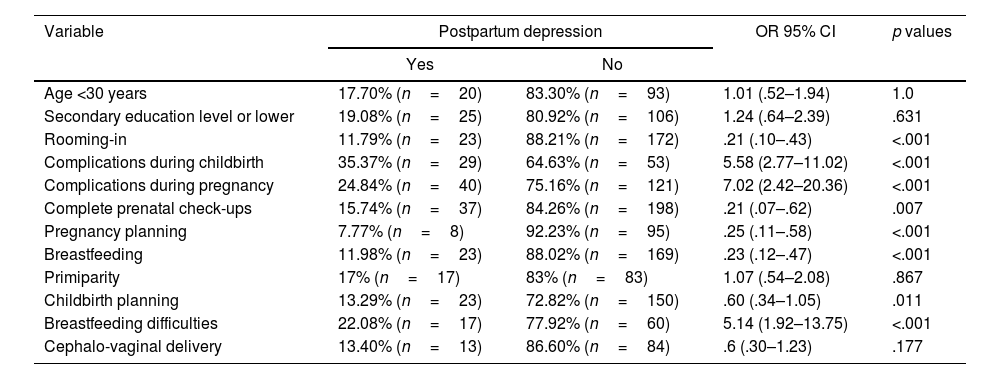Perinatal factors such as lack of breastfeeding, complications during pregnancy or childbirth, and psychosocial factors such as maternal psychiatric history or socioeconomic status have been associated with the development of postpartum mood disorders. The combination of these factors during the peripartum can predict the development of maternity blues (MB) and postpartum depression (PD).
ObjectiveTo characterize risk factors associated with MB and PD in Ecuadorian women going through their immediate puerperium in the gynecology and obstetrics service of “Hospital General San Francisco” in Quito-Ecuador.
MethodA cross-sectional study was conducted, with a sample of 250 women attending their immediate puerperium. Data was collected using a self-applied questionnaire during the first 24 postpartum hours. Stein blues scale (SBS) was applied for MB screening and the Edinburgh Postpartum Depression Scale (EPDS) for PD screening. Informed consent and data confidentiality were explained to all participants.
ResultsUsing the SBS, a probability of MB of 32.4% (n=81) was observed, while applying the EPDS, a PD probability of 17.6% (n=44) was established. MB and PD protective factors were rooming-in (OR .21, p<.001) (OR .21, p<.001), pregnancy planning (OR .13, p<.001) (OR .25, p<.001) and breastfeeding (OR .20, <.001) (OR .23, p<.001). Meanwhile MB and PD risk factors found were: breastfeeding difficulties (OR 5.88, p<.001) (OR 5.14, p<.001), complications during pregnancy (OR 8.39, p<.001) (OR 7.02, p<.001), complications during delivery (OR 5.29, p<.001) (OR 5.58, p<.001) and economic instability (OR 2.10, p .023) (OR 2.61, p .009).
Discussion and conclusionThe risk and protective factors associated with MB and PD in the Ecuadorian population are similar to those described internationally. The recognition of risk factors by health personnel can improve early identification and timely management of puerperal mood disorders.
Factores perinatales como la ausencia de lactancia materna, complicaciones durante el embarazo o parto y factores psicosociales como antecedentes psiquiátricos de la madre o nivel socioeconómico se han asociado con el desarrollo de trastornos del estado de ánimo puerperales. La combinación de estos puede predecir el desarrollo de maternity blues (MB) y depresión posparto (PD).
ObjetivoCaracterizar factores de riesgo asociados a MB y PD en mujeres ecuatorianas cursando su puerperio inmediato en el Servicio de Ginecología y Obstetricia del Hospital General San Francisco en Quito-Ecuador.
MétodoSe realizó un estudio transversal con 250 mujeres cursando su puerperio inmediato. Los datos se recogieron mediante un cuestionario que fue aplicado durante las primeras 24 horas posparto, se aplicó la escala de blues de Stein (SBS) para determinar MB y la escala de depresión posparto de Edimburgo (EPDS) para determinar PD. Todas las participantes aceptaron el consentimiento informado.
ResultadosUtilizando la SBS se observó una probabilidad de MB de 32,4% (n=81), mientras que aplicando la EPDS se estableció una probabilidad de PD de 17,6% (n=44). Los factores protectores de MB y PD fueron: alojamiento conjunto (OR 0,21 p<0,001) (OR 0,21 p<0,001), planificación del embarazo (OR 0,13 p<0,001) (OR 0,25 p<0,001) y lactancia materna (OR 0,20 <0,001) (OR 0,23 p<0.001). Los factores de riesgo para MB y PD fueron: dificultades en la lactancia (OR 5.88 p<0.001) (OR 5.14 p<0.001), complicaciones del embarazo (OR 8.39 p<0.001) (OR 7,02 p<0,001), complicaciones del parto (OR 5,29 p<0,001) (OR 5,58 p<0,001) e inestabilidad económica (OR 2,10 p 0,023) (OR 2,61 p 0,009).
Discusión y conclusiónLos factores de riesgo y factores protectores asociados a MB y PD en la población ecuatoriana son similares a los descritos internacionalmente. El reconocimiento de los factores de riesgo por parte del personal de salud puede mejorar la identificación temprana y el manejo oportuno de los trastornos del estado de ánimo puerperal.











